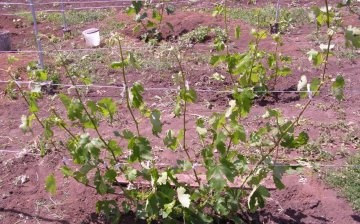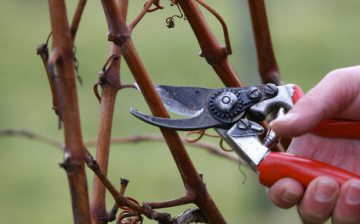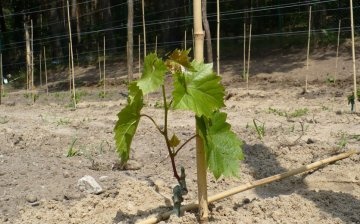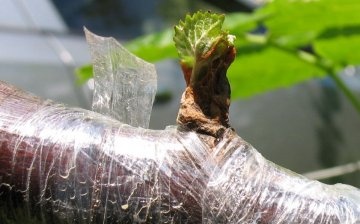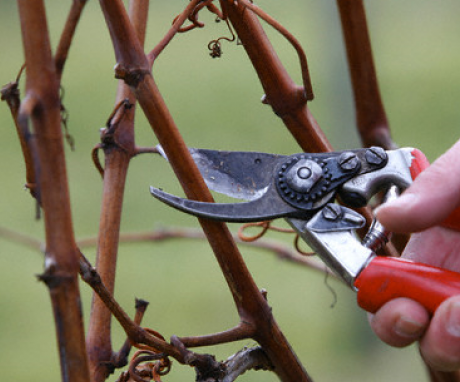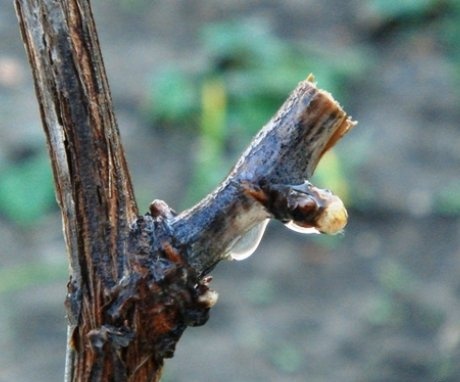Grape care in spring: grafting, planting, feeding and pruning
A grape is a bush that twists and produces fruits in the form of berries. When grapes are grown from seeds, they germinate in the first year after planting. The next year, you can see long and very well developed shoots. The flowers of this plant are very small.
They gather in inflorescences or panicles, on which berries are later formed. Grapes can be green, blue, purple, pink, lemon colors. In order to ensure the full development of the grapes and a high yield, it is necessary to take very good care of them in the spring.
Content:
- How to feed grapes in the spring
- Pruning grapes
- Grape processing
- Features of planting and grafting of grapes
How to feed grapes in the spring
In the event that in the spring there is not enough moisture or mineral nutrients in the soil you need to make top dressing... Also, this action is performed when the grape root system freezes.
Features of feeding:
- Top dressing of grapes in the spring is best done at the root. For this purpose, mineral fertilizers are most often used.
- It is best to start caring for grapes in the spring from the first half of April.
- Fertilizer under the bushes must be applied before the growth of the shoots. In the event that phosphorus-potassium and organic fertilizers were not applied under the bushes in the autumn period, then in the spring a complex mineral fertilizer is applied.
To perform this action, it is necessary to mix 140 grams of ammonium nitrate, 120 grams of magnesium sulfate, 110 grams of superphosphate, 30 grams of magnesium sulfate with water for irrigation. This amount of fertilizer must be applied under bushes, the average yield of which is from 12 to 15 kilograms.
Phosphorus-potassium fertilizers must be applied to the depth in which the main roots of the bush lie.
To do this, you need to make special punctures into the soil using a metal pin. In the event that humus is used as a fertilizer, then it is necessary to apply only half of the norm of ammonium nitrate.
Pruning grapes
For that to properly prune grapes in the spring, it is necessary to carry out the preparatory work correctly. To do this, it is necessary to very carefully examine the bush of this plant, paying attention to the buds and tissue damage on the branches.
For grapes, pruning is quite a painful procedure, as it causes a very large number of wounds. In order to mitigate the negative consequences, the gardener needs to take a certain number of measures.
To remove thin shoots of grapes, you must:
- Use a pruner, and for thicker ones, a hacksaw.
- In order for the pruning to be done quickly enough and less painful for the grapes, it is necessary to sharpen the pruner knife very well, and lubricate its springs with oil.
- To ensure even and smooth cuts, it is necessary to place the knife on the side of the shoot, which is left.
- The emphasis of the secateurs must be done on the part that is cut off. Slices must have minimum diameter.
In the event that replacement knots are left below the fertile vine every year, then the slices can be placed on one side.
Thanks to this, liquid and nutrients will flow to all organs of the bush. After the branches are cut with a hacksaw, they must be trimmed with a pruner. Thanks to this, the surface of the wounds will become as smooth as possible. If this procedure is not performed, then water can be retained on the cuts, which will lead to the appearance of fungus or other dangerous grape diseases.
Pruning Secrets:
- Pruning of grapes should be done in April before sap flow begins.
- When pruning this plant, it is necessary to initially thin out the bushes by removing diseased, dead and weak branches. This will limit the loss of water and nutrients by healthy vines.
- Thick and strong branches must be carefully bent towards the tool and cut with a slow sliding motion. In this case, it is necessary to ensure that the vines do not flatten during pruning.
Bushes over two years old are cut by 60 percent. Moreover, they need shorten by about five buds... When working with old branches, you need to make every effort to keep the cuts as small as possible. Otherwise, the plant tissue of the grapes will die off. If the branches are removed at the base of the bush, then it is necessary to leave small pads of 0.5 centimeters in size. To form the skeleton of a grape bush, two pieces of perennial vines are needed, on which young shoots will grow.
On all "sleeves" of the grapes, it is necessary to leave a short part of last year's vine, which has several shoots.
In this case, the replacement knot must be shortened by several buds. The fruit arrow must be cut into no more than 6 buds. At the same time, do not forget that these branches are responsible for the fruiting of grapes. Therefore, work in this area must be carried out as carefully as possible.
In order for the grape bush to fully develop in the future, it is necessary to leave a high-quality replacement knot. In the first year, the gardener will need to grow several powerful shoots, and in the second year, develop four shoots. Correct pruning of grapes will ensure full development of this plant.
Grape processing
In order to protect grapes from various diseases during flowering and fruiting, need to handle it such solutions in the spring:
- Oxyhom.
- Bordeaux liquid.
- Karbofos.
These insecticides develop the plant's immunity to a variety of diseases. When choosing an insecticide, it is necessary to pay attention to the grape variety and the peculiarities of its development. They help grapes not only to avoid various diseases, but also protect them from pests.
How to fight grape diseases:
- In the event that the grapes are affected by bacterial cancer, which manifests itself in the form of specific growths on the branches, then it is necessary to cut out the affected areas from the bush and burn them. This will limit the spread of the disease in the garden.
- All grape wounds must be lubricated with a special solution in the form of ammonium dichromate or hydrogen peroxide. After the solution dries, the wounds must be lubricated with garden varnish.
- Grape bushes that are affected by this disease are planted on a special diet, which implies a reduction in watering and dressing by two to three times. Thanks to this, the immunity of the vineyard will increase significantly.
Every gardener should remember that plants that carry any disease cannot be turned into a mother plant. for propagation by cuttings.
Such grapes can only be used with the purpose of harvesting... In order to avoid diseases of grapes in the spring, it is necessary to carry out preventive work, which consists in reducing watering, as well as in minimizing fertilizing the bush from humus and fresh manure. Thanks to proper care of grapes in the spring, you can completely get rid of its diseases and pests.
Features of planting and grafting of grapes
In order to grow a high-yield grape bush, it is necessary make it fit correctly... Preparation of material for planting grapes is carried out at the beginning of March. But it is best to carry out this action in the spring, and in the spring you will only need to check the ability of the vine to germinate. For this, the vine is placed in water for a while.
Planting harvested cuttings and vines are produced in May. In this case, the frosts should finally end, since after surviving the slightest frost, the vine may not take root.
Before planting grape seedlings, it is imperative to check their root system.
How to plant grapes in spring:
- Seedlings must be carefully studied, which will limit the possibility of diseases on new bushes.
- When planting grapes, it is necessary to prepare the pit very carefully. It should be 10-15 centimeters larger than the root system of the seedling.
- After planting a grape seedling, he needs to ensure regular and abundant watering. This will ensure high-quality engraftment of the cuttings and seedlings.
- In order to speed up the process of grape engraftment, it is necessary to use growth stimulants.
- Cuttings and seedlings are treated in a growth stimulant solution before planting in the ground.
In order to develop new grape varieties, it is necessary to inoculate it.
One of the easiest ways to graft is to bud the lignified scutes. The graft must be prepared according to generally established rules. In the autumn, it is necessary prepare cuttings plants and store them in the refrigerator. The storage temperature of cuttings should not exceed +5 degrees. In this case, it is necessary to ensure that the cuttings do not dry out. To do this, wrap the root of the cutting in a wet cloth.
Before grafting grapes, cuttings must:
- Soak for two days before work in a growth stimulator.
- Next, you need to choose a bush and a vaccination site.
- The cuttings must be planted at a distance of one meter from the head of the bush.
- In the event that cuttings are made on an old plant, then it is necessary to preserve the shoots. In the future, excess shoots are removed.
- For successful budding with cuttings, you need to use a sharpened knife, which is characterized by a high level of sterility.
- Also, the cut points should be open for the shortest possible period of time. That is why it is necessary to irrigate the cut points, and to dip the bud into and the stalk must be done with careful and smooth movements up and down.
- Several leaves must be left above the vaccination. These leaves will further work as a pump. With their help, the junction will be provided with all the necessary nutrients.
- The vaccination site is wrapped with a stretch film or cloth for two weeks.
Taking care of grapes in the spring is a fairly simple process. In order for this plant to give a full and rich harvest, it needs to ensure not only correct planting, but also pruning, watering and fertilizing.
More information can be found in the video.




